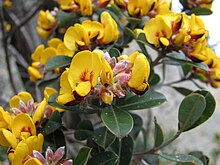Pultenaea
| Pultenaea | |
|---|---|

| |
| Pultenaea daphnoides in Kooyoora State Park | |
| Scientific classification | |
| Kingdom: | Plantae |
| Clade: | Tracheophytes |
| Clade: | Angiosperms |
| Clade: | Eudicots |
| Clade: | Rosids |
| Order: | Fabales |
| Family: | Fabaceae |
| Subfamily: | Faboideae |
| Clade: | Mirbelioids |
| Genus: | Pultenaea Sm.[1] |
| Type species | |
| Pultenaea stipularis | |
| Species | |

| |
| Range of Pultenaea Sm. | |
| Synonyms[1] | |
| |

Pultenaea is a genus of about 100 species of flowering plants in the family Fabaceae, and is endemic to Australia. Plants in this genus are shrubs with simple leaves and orange or yellow flowers similar to others in the family but with the standard petal equal to or slightly longer than the other petals.
Description
[edit]Plants in the genus Pultenaea are erect to low-lying or prostrate shrubs with simple leaves usually arranged alternately, usually with papery stipules. The flowers are usually orange or yellow with red marking and usually arranged in leaf axils, often in a condensed raceme near the ends of branchlets. There are bracts that are sometimes replaced by enlarged leaf stipules and the bracteoles are usually attached to the base of the sepal tube. The standard petal is equal in length or only slightly longer than the keel and wings. All ten stamens are free from each other, the ovary is usually sessile and the fruit is a small, egg-shaped pod with the remains of the style attached.[2][3][4][5]
Taxonomy
[edit]The genus Pultenaea was first formally described by botanist James Edward Smith in 1794 in A Specimen of the Botany of New Holland.[6] The first species he described was P. stipularis from a living specimen raised in Stockwell, England from seed obtained from New South Wales in 1792.[7] Smith named the genus in honour of Richard Pulteney, an English surgeon and botanist, who also was the biographer of Linnaeus.[8]
Species list
[edit]Phylogeny
[edit]Pultenaea belongs to the Mirbelioid clade of the legume subfamily Faboideae. Pultenaea is paraphyletic with respect to several of the other mirbelioid genera.[9][10]
The genus is not considered to be monophyletic[11] with suggestions of splitting it into six separate subgenera, under a larger genus of Pultenaea sensu lato, which would include 19 out of 25 genera included in the former tribe Mirbelieae.[12]
Speciation
[edit]The Mirbelioids have had long isolation in Australia from other Fabaceae families. Pultenaea Sm. underwent explosive starburst radiation during the late Miocene, due to aridity.[12] Geographic speciation factors include east vs. west endemism due to increased aridity and the development of the Nullarbor Plain; subgenera Pultenaea and Corrickosa of eastern Australia split along the Winter–Summer rainfall boundary; subclades within Corrickosa diverged due to marine incursions between South Australia and Victoria. Western Australian species include disjunctions between north and south, and Esperance/Cape Arid. Recent extinctions, possibly due to changed fire regimes and grazing pressure, include P. elusa and P. maidenii.[13]
Distribution
[edit]Species of Pultenaea occur in all Australian states and the Australian Capital Territory but not the Northern Territory.[1]


Use in horticulture
[edit]A number of species are cultivated for their spring flower display. Most of these are fast-growing and adaptable to diverse growing conditions. Propagation is from semi-mature cuttings or seed pre-treated by soaking in hot water.[14]
Three cultivars are registered with the Australian Cultivar Registration Authority:
- Pultenaea pedunculata 'Pyalong Gold'
- Pultenaea pedunculata 'Pyalong Pink'
- Pultenaea villosa 'Wallum Gold'—a prostrate form[15]
References
[edit]- ^ a b c "Pultenaea". Australian Plant Census. Retrieved 17 June 2021.
- ^ "Genus Pultenaea". Royal Botanic Garden Sydney. Retrieved 17 June 2021.
- ^ "Pultenaea Sm". FloraBase. Western Australian Government Department of Biodiversity, Conservation and Attractions.
- ^ "Pultenaea". State Herbarium of South Australia. Retrieved 17 June 2021.
- ^ Corrick, Margaret G. "Pultenaea". Royal Botanic Gardens Victoria. Retrieved 17 June 2021.
- ^ "Pultenaea". Australian Plant Name Index. Retrieved 17 June 2021.
- ^ Smith, James E. (1794). A Specimen of the Botany of New Holland. Vol. Botany. London. pp. 35–38. Retrieved 17 June 2021.
- ^ Crisp M. (2 May 2009). "Fabaceae tribe Mirbelieae: Pultenaea". The Australian National University. Archived from the original on 14 October 2009. Retrieved 15 October 2009.
- ^ Crisp M, Cook LG. (2003). "Phylogeny and embryo sac evolution in the endemic Australasian papilionoid tribes Mirbelieae and Bossiaeeae". In Klitgaard BB, Bruneau A (ed.). Advances in Legume Systematics, Part 10: Higher Level Systematics. Royal Botanic Gardens, Kew. pp. 253–268. ISBN 9781842460542.
- ^ Bickford SA, Laffan SW, de Kok RPJ, Orthia LA. (2004). "Spatial analysis of taxonomic and genetic patterns and their potential for understanding evolutionary histories". Journal of Biogeography. 31 (11): 1715–173. Bibcode:2004JBiog..31.1715B. doi:10.1111/j.1365-2699.2004.01127.x. S2CID 84466412.
{{cite journal}}: CS1 maint: multiple names: authors list (link) - ^ Orthia LA, Cook LG, Crisp MD. (2005). "Generic delimitation and phylogenetic uncertainty: An example from a group that has undergone an explosive radiation". Aust Syst Bot. 18 (1): 41–47. doi:10.1071/SB04016.
{{cite journal}}: CS1 maint: multiple names: authors list (link) - ^ a b Orthia LA, Cook LG, Crisp MD, deKok RPJ. (2005). "Bush peas: A rapid radiation with no support for monophyly of Pultenaea (Fabaceae: Mirbelieae)". Aust Syst Bot. 18 (2): 133–147. doi:10.1071/SB04028.
{{cite journal}}: CS1 maint: multiple names: authors list (link) - ^ de Kok RPJ, West JG. (2004). "A revision of the genus Pultenaea (Fabaceae). 3. The eastern species with recurved leaves". Aust Syst Bot. 17 (3): 273–326. doi:10.1071/SB02028.
- ^ Greig D. (1987). The Australian Gardener's Wildflower Catalogue. Australia: Angus & Robertson. ISBN 978-0207154607.
- ^ "List of Registered Cultivars derived from Australian native flora". Australian Cultivar Registration Authority. Retrieved 2009-10-14.
![]() Media related to Pultenaea at Wikimedia Commons
Media related to Pultenaea at Wikimedia Commons
